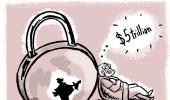One could argue that India is not troubled in the same way as China is by a declining population and structural problems in real estate/construction and finance.
But India has serious trade and fiscal imbalances, and excessive dependence on capital expenditure by the government, points out T N Ninan.

For two years in a row, the Indian economy has grown faster than China's.
The 7 per cent projected for this fiscal year compares with an uncharacteristically low 3 per cent for China in calendar year 2022.
Similarly, last year's 9.1 per cent for India trumped China's 8.1 per cent.
This comes on top of the relative performance of the two most populous countries in the five years before there was any sign of Covid (the calendar years 2014-2018, and their corresponding fiscal years for India).
That is when India outpaced China for the first time -- averaging 7.4 per cent growth, while China managed 7 per cent.
Thus began the narrative of India as the world's fastest-growing large economy, dethroning China after some three decades when Beijing had cornered all the glory.
But as always with such numbers, the story line can change when you play around with the period chosen for study.
What's missing in the picture presented in the previous paragraph are the two intervening years of 2019 and 2020, when China managed to do better than India; and to do so by such a wide margin as to flip the two countries' positions when it comes to longer-term growth averages.
China grew by 6 per cent in 2019 compared to India's 3.9 per cent for 2019-2020, and by 2.2 per cent in the first Covid year when India's gross domestic product shrank by 5.8 per cent.
Taking the full nine years (2014-2022) together, therefore, China pipped India to the post with average growth of just over 6 per cent, compared to India's 5.7 per cent.
Even if one looks at just the last four years, starting from the pre-Covid year, China outpaced India.
This somewhat uncertain result of the race, when one tries to gauge which really is the world's fastest-growing large economy, should make one cautious about projections for the future.
Until very recently, most forecasters had it that India would do significantly better than China in 2023 (2023-2024).
The International Monetary Fund, for instance, postulated China's growth at 4.4 per cent against 6.1 per cent for India.
But this scenario has undergone a change in recent weeks, as China has altered course dramatically and given up its zero-tolerance policy on Covid, with the attendant shutdowns and disruptions.
As a result, one forecaster after another has upped China's growth figure for 2023.
Most have moved up their China forecast to the region of 5.5 per cent; the more optimistic ones place it slightly higher.
That is below the 6-6.8 per cent range held out for India in the Economic Survey of a month ago, with a mid-line forecast of 6.5 per cent.
The question is whether this latter picture changes for the worse after India's October-December GDP growth number has come in at just 4.4 per cent. Might the two cheetahs end up in another dead heat?
The government has argued that the latest quarterly growth figure has suffered on account of small upward revisions of the previous three years' growth numbers.
Perhaps, but the growth number for the current January-March quarter is projected at no more than 5.1 per cent.
And the chief economic advisor has been frank enough to admit that the downside risks now outweigh any possible upsides.
The modified outlook is underlined by the February collections from goods and services tax.
At Rs 1.49 trillion, they show little or no growth over recent months.
In other words, there is no sign -- yet -- of the momentum that would propel India from a 5 per cent growth trajectory to 6 per cent and more.
If so, the short-term outlook for the Indian economy is not very different from that for China.
One could argue that India is not troubled in the same way as China is by a declining population and structural problems in real estate/construction and finance.
But India has serious trade and fiscal imbalances, and excessive dependence on capital expenditure by the government.
The message is clear: If there is a growth race between India and China, there is as yet no one winner.











